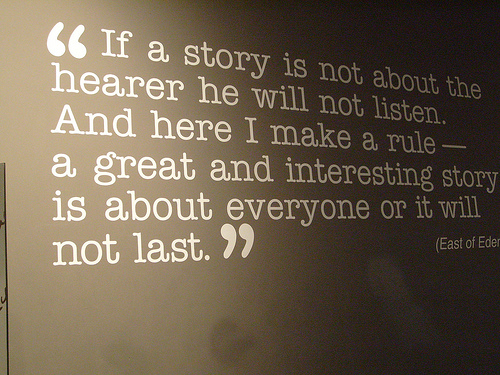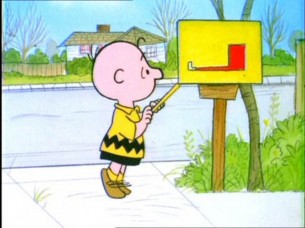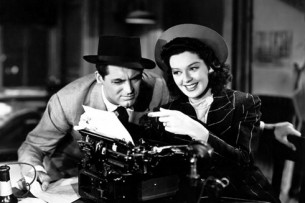This entry is part of a series of #moznewslab posts that I’ll publish over the course of my time as a participant in the Knight-Mozilla learning lab. On the merits of a video idea “that will improve the way that online news is produced or experienced” I was invited to the second round of the Knight-Mozilla Fellowship. I’ll be using posts such as this to reflect and share what I’ve learned in class and develop my final open-source project, which I hope to be invited to prototype in the next round. Your feedback, positive and negative, is very encouraged and welcome. Seriously!
A man walks into a bar and sits down at the counter. He doesn’t want a drink, he’s just stopped in to rest his feet. The bartender leaves him be, but as the man winches in pain and starts to apply duct tape to his shoes, eventually curiosity prevails.
“I see you come in here year after year and every time you say your shoes make your feet hurt and you tape them back together, so why do you wear them,” the bartender asks.
The man looks up from his seat and puts down the duct tape.
These are the greatest shoes in the world he tells the barrel chested beer shepherd. He goes on to tell the man of how he’s sold millions of them around the world, how loyal his fans are, how they bought his house and how happy everyone is when the buy them, see them or talk about them.
The bartender looks him up and down and picks up the duct tape from the counter.
But they have no arc support, fall apart within months, make your feet stink; as the bartender extols the virtues of alternatives, the man smiles and takes his seat. He goes on: are manufactured in China and bring with them allegations of exploitation of migrant labor and also there’s some who would say its owner exploits children and engages in poverty tourism.
Then there’s this:
“I sold 10,000 pairs my first year and now have Nordstrom, Macy’s and a slew of other retailers knocking on my door,” the man responds.
If you haven’t figured it out, I’m talking about Toms shoes, the shoe company best know for its buy one give one model for humanitarian aid, in which western consumer purchase one pair of shoes for the price of two with the intention of delivering the other pair to a child in need.
Since opening up shop in 2006, Toms have grown into a major brand with sales in the millions and a very loyal following. A true business success story by any account, yet that’s not the narrative the company is pushing. In fact it downplays it, such as when it refuses to release exact sales figures and instead offers to provide an equation for figuring it out based on how many shoes were given away, thus ensuring the shoe give away is present in the story.
It is this aspect of giving away the shoes to children in need that has fueled Toms’ gains, and yet a funny thing is happening here
A quick scan of Amazon, YouTube and consumer sites found many folks who were dissatisfied with their purchase for its poor quality and apparently awful customer service ( I did not find one review that praised or was even lukewarm toward their customer service experience), and yet they remain in business and consumers continue to buy the shoes.
Why?
It’s the story. The story of a founder who traveled the world and wanted to change it with a simple solution is universal, marketable and just genuine enough in it’s earnest attempt to provide humanitarian aid.
It’s a story you can buy into, a story you can share a story that could be your story if you put on the shoes and tell everyone you meet about it. That’s pealing, because stories have power and influence. They can sell an idea, tap into an emotion, teach us about ourselves or sometimes even sell a pretty crappy shoe.
During the first installment of Knight-Mozilla learning lab, guest instructor Aza Raskin eluded to the idea that stories have power to influence. (Psst, check out the class, it’s VERY worth your hour.)
Raskin made a strong point out of reminding us that the value of an idea is null unless it can be communicated. To some that may seem like a prompt to create an informal pitch, a video demonstration or a prototype in great detail, but it’s much much more than that.
As Raskin presents in the following slides (skip to slide 47) when pitching something creative, you’re not selling the idea, you’re selling the dream of what the idea means.
Why do people want something?
Story has the power to influence and sell an idea, either by letting them see for themselves how it changes their lives or by forming an emotional attachment.
In our everyday lives there are dozens of stories that we’ve bought into without even realizing it.
Is one brand of toothpaste that different from the other? Is Heinz ketchup that much better than Hunt’s ketchup? Will a Toyota Prius be better for the environment than a Vespa scooter?
We make arbritaty choices and hold strong loyalties to products not because they are better, but because they make us feel like they are the better choice. We attach feeling to products because the story they carry with them is so appealing and influencing over our behavior: the Prius is “green,” mom always bought Campbell’s soup, Ritz crackers and 7-up make me feel good when I’m sick.
In the case of Toms, it’s the story that you’re helping someone fulfill a dream for a higher purpose and helping others in the process.
In thinking about my own project for #mozenewslab, I’m falling back on my experience as a photojournalist and trying to answer the same question I always have with every story: What is it and why should anyone care?
For this project that means thinking about how news gathers and news consumers would use the product in the real world and what benefits they would recieve that would be high enough to add another item to their work flow or morning rituals.
It’s not enough to make something cool, you also have to sell the story of how it makes their life better in order to garner investment of support, resources and most of all, collaborators to reach the goal.


